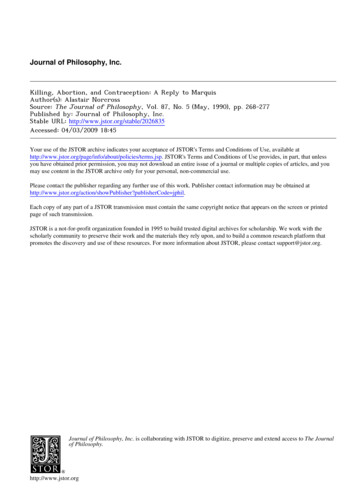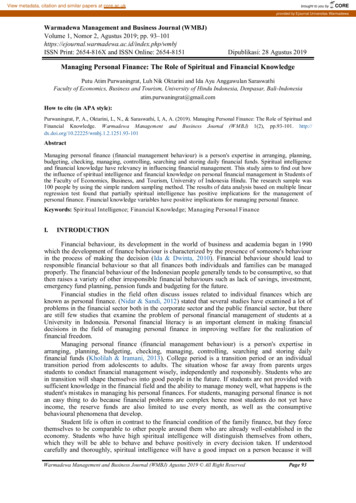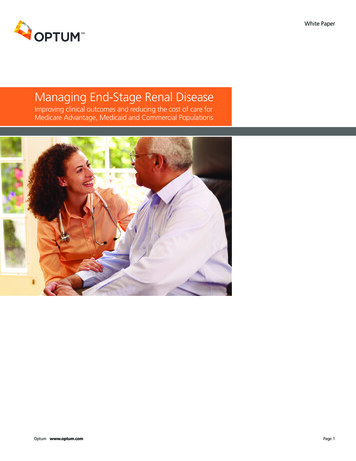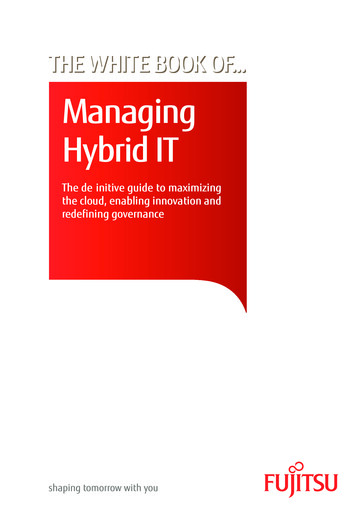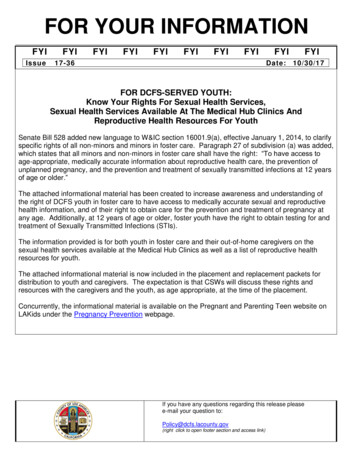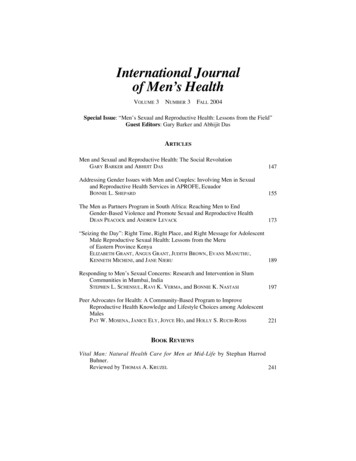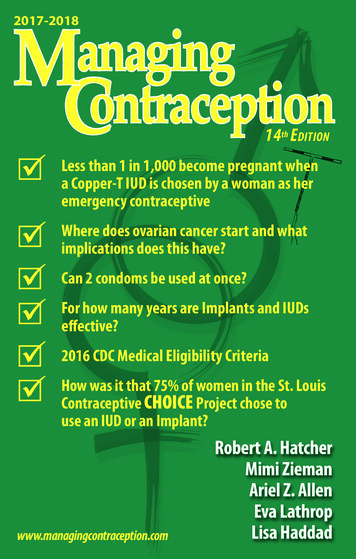
Transcription
ManagingContraception2017-201814th EditionüLess than 1 in 1,000 become pregnant whena Copper-T IUD is chosen by a woman as heremergency contraceptiveüüüüüWhere does ovarian cancer start and whatimplications does this have?Can 2 condoms be used at once?For how many years are Implants and IUDseffective?2016 CDC Medical Eligibility CriteriaHow was it that 75% of women in the St. LouisContraceptive CHOICE Project chose touse an IUD or an Implant?www.managingcontraception.comRobert A. HatcherMimi ZiemanAriel Z. AllenEva LathropLisa Haddad
TA B L E O F CO N T E N T SDedication, Acknowledgments, How to Use this Book / Important Phone Numbers . 3Abbreviations Used in This Book . 10FAMILY PLANNING ESSENTIALS12345678910111213Menstrual Cycle. 13Counseling Guidelines and the St. Louis Contraceptive CHOICE Project . 17Providing Quality Family Planning Services (QFP) . 22Taking a Sexual History . 25Cervical Cancer Screening and HPV Vaccines. 26Adolescent Issues . 29Male Reproductive Health . 33Perimenopause and Menopause . 35Prepregnancy Planning and Preparation . 37Pregnancy Testing . 39Postpartum Contraception . 41Elective Abortion. 44Choosing Among Available Methods . 51CONTRACEPTIVE e or Delaying Sexual Intercourse. 65Breastfeeding: Lactational Amenorrhea Method (LAM) . 65Breastfeeding and Contraceptive Decisions . 69Fertility Awareness Methods (FAM) . 70Condoms for Men . 76Female-Controlled Barrier Methods . 83Spermicides . 88Coitus Interruptus (Withdrawal) . 91Emergency Contraception . 93Intrauterine Contraceptives . 106Combined (Estrogen & Progestin) Contraceptives . 126Progestin-Only Contraceptives . 155Female Sterilization: Tubal Ligation or Occlusion . 174Male Sterilization: Vasectomy . 184Ordering and Stocking Devices . 181Sexually Transmissable Infections (STI's) CDC Guidelines . 186Evaluation & Management of Sexual Assault . 209References . 210Spanish/English Translations of Key Family Planning Words . 220Index . 221How to order this book and other publications . 237Color Photos of Pills . 245Margaret Sanger and Condoms . 260The History of Contraception and Population Growth . 261Who Can use Which Contraceptives? The Question Clinicians Face Daily . 263Summary of 2016 US Medical Eligibility Criteria for Contraceptive Use. 264
ManagingContraception2017-201814th EditionwwJune 2017w.Man Ordag erin cgC opon iestr oac neption.comRobert A. HatcherMimi ZiemanAriel Z. AllenEva LathropLisa Haddad
COPYRIGHT INFORMATIONManaging Contraception 2017 by Robert A. Hatcher, Mimi Zieman,Ariel Z. Allen, Eva Lathrop and Lisa Haddad and The Bridging the GapFoundation. The extent to which this book is used to help others is now in yourhands.If we used an entire table, figure, or direct quote from anotherpublication, you must request permission to use that information from theoriginal author and publisher.Suggested formal citation:Hatcher RA., Zieman M, Allen A. Z., Lathrop E, Haddad L, ManagingContraception 2017-2018. Tiger, Georgia: Bridging the Gap Foundation.IMPORTANT DISCLAIMERThe authors remind readers that this book is intended to educate healthcare providers, not guide individual therapy. The authors advise a person witha particular problem to consult a primary-care clinician or a specialist inobstetrics, gynecology, or urology (depending on the problem or thecontraceptive) as well as the product package insert and other referencesbefore diagnosing, managing, or treating the problem. Under no circumstances should the reader use this handbook in lieu of or to override thejudgment of the treating clinician. The order in which diagnostic or therapeuticmeasures appear in this text is not necessarily the order that clinicians shouldfollow in each case. The authors and staff are not liable for errors or omissions.Fourteenth Edition, 2017-2018ISBN 978-0-692-55734-1Printed in the United States of AmericaBridging the Gap FoundationOn 267 pages, we cannot possibly provide you with all the information youmight want or need about contraception. However, many of the questions clinicians ask are answered in this book, Managing Contraception 2017-2018, orthe textbook Contraceptive Technology.
ManagingContraception2017-201814th EditionRobert A. Hatcher, MD, MPHProfessor Emeritus of Gynecology and ObstetricsEmory University School of MedicineMimi Zieman, MDVice President, Clinical AffairsFemasys Inc.Ariel Z. AllenResearch Assistant at the Contraceptive Choice CenterWashington University School of MedicineMedical Student starting in August 2017Eva Lathrop, MD, MPHAssociate Professor of Obstetrics and Gynecology and Global HealthAssistant Director, Fellowship in Family PlanningEmory University School of MedicineLisa Haddad, MD, MS, MPHAssistant Professor of Obstetrics and GynecologyEmory University School of MedicineTechnical and Computer Support for both Managing Contraception andContraceptive Technology:DID Media, LLC., Cornelia, GeorgiaJason Blackburn706-776-2918jason@didmedia.comSpecial thanks to Karli R. Kerrschneider BSN, RN for many suggestions that improved thisedition of Managing Contraception. She will receive her Masters of Science in Nursing throughFrontier Nursing University in June 2017.Previous editions of this book enjoyed the support of both the Packard Foundation and ananonymous foundation.The Bridging the Gap Foundation Tiger, GeorgiaPlease consider making a contribution to this 501-C3 organization.The extent to which we can make this 2017-2018 edition of Managing Contraception available to medical students, residents and family planning programs internationally depends oncontributions from people like you. Since the first edition of Managing Contraception, over800,000 of the 1,115,000 copies of this book have been given away at no cost to medicalstudents, residents, nursing and nurse midwifery students and family planning nurse andpractioners.3
Ariel Z. Allen Eva Lathrop Lisa Haddad anaging Contraception M2017-2018 14th Edition. 2 COPYRIGHT INFORMATION . DID Media, LLC., Cornelia, Georgia Jason Blackburn 706-776-2918 jason@didmedia.com Special thanks to Karli R. Kerrschneider BSN, RN for many suggestions that improved this

